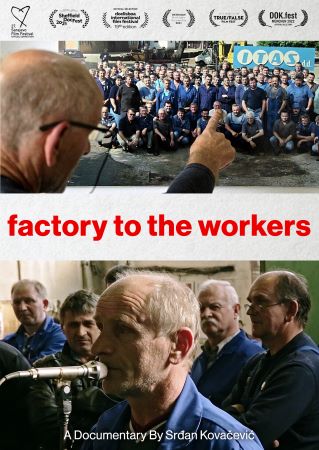
Factory to the Workers 2021
Distributed by epf media, 324 S. Beverly Drive, PMB 437, Beverly Hills, CA 90212; 310-839-1500
Produced by Sabina Krešić and Luka Venturin
Directed by Srđan Kovačević
Streaming, 106 mins
High School - General Adult
Croatia; Employee-Owned Business; Free Market Economy; Socialism
Date Entered: 09/26/2023
Reviewed by Suzanne Mangrum, Acquisitions Librarian, Middle Tennessee State UniversityFactory to the Workers is a documentary about the current precarious fate of the ITAS machine tool factory in Croatia. Under the Yugoslavia socialist regime, it employed 900 workers. The workers resisted a privatization attempt after the Yugoslav wars by occupying the factory and refusing to let go. The privatization attempt failed, and since 2005, the factory was left to the workers. It is now based on a self-governing system where the workers decide on company policies together. However, the factory cannot seem to catch up with free market demands. ITAS is at constant risk of collapse, employs less than 200 workers, has a high turnover rate, and the management cannot pay out full salaries.
As a GenX American who remembers Yugoslavia vaguely from elementary through high school, this film was challenging to process. There are numerous long scenes of workers smoking and staring out the window, watching a solitary worker walk down a long, dark corridor, only to turn and walk down another dark corridor. The facility looks run down and half abandoned. Within the first minute, the chain-smoking protagonist, Varga, argues with an older machinist about completing a job. When the machinist contends that it may not be possible, Varga states, “It wasn’t a problem when you were drinking brandy in here yesterday.” This film is dreary. However, if one can be patient through the scenes, the plight of the workers unfolds, and their anxiety and what is at stake becomes all too vivid. There is a fire inside many of them to hold on to what is theirs and maintain an employee-owned operation. This resonates with many in the world today.
I cannot precisely describe the audience or goals of this film. After reading an interview with the director, Srdan Kovačević, I was relieved to find that he wasn’t sure either. In an interview in the East European Film Bulletin, Kovačević said he expected to find a socialist triumph: an employee-owned and managed manufacturing operation. Instead, he found a gloomy organization struggling to keep up with the modern economy. Kovačević wanted to focus on the workers’ effort to win the right to have a say in their own destinies. I would say this film is less about the protest of workers and more about the fit of a Socialist, employee-run operation in the 21st century. It leaves the audience with more questions than answers, but I had rich discussions with colleagues and friends just explaining what the film is about. It could take a classroom in many directions. This group of employees is holding on to a factory occupation victory that is almost 20 years old and struggles to keep their socialist dream alive in a free market economy. Is this an economic struggle that is found the world over? Are they political outcasts in a post-war Croatian society? Is it because corrupt directors undersell the work and take cuts off the top? Was this employee-owned operation doomed to fail from the beginning due to its financial structure? Or, as one young manager says in the most poignant part of the documentary, are they simply fools tilting at windmills?
Factory to the Workers is not joyful but could be extremely valuable in a classroom. It covers a unique slice of a post-war economy. It shows how Croatian workers deal with the same struggles that companies worldwide face in a free-market economy but through a particular philosophical lens. What makes them different? What makes them the same? How could they remain viable in the 21st century? This film could be helpful to political science, economics, sociology, global studies, and history courses. It will absolutely generate discussion and would be a good addition to academic library collections.
Published and licensed under the Creative Commons Attribution 4.0 license. Anyone can use these reviews, so long as they comply with the terms of the license.